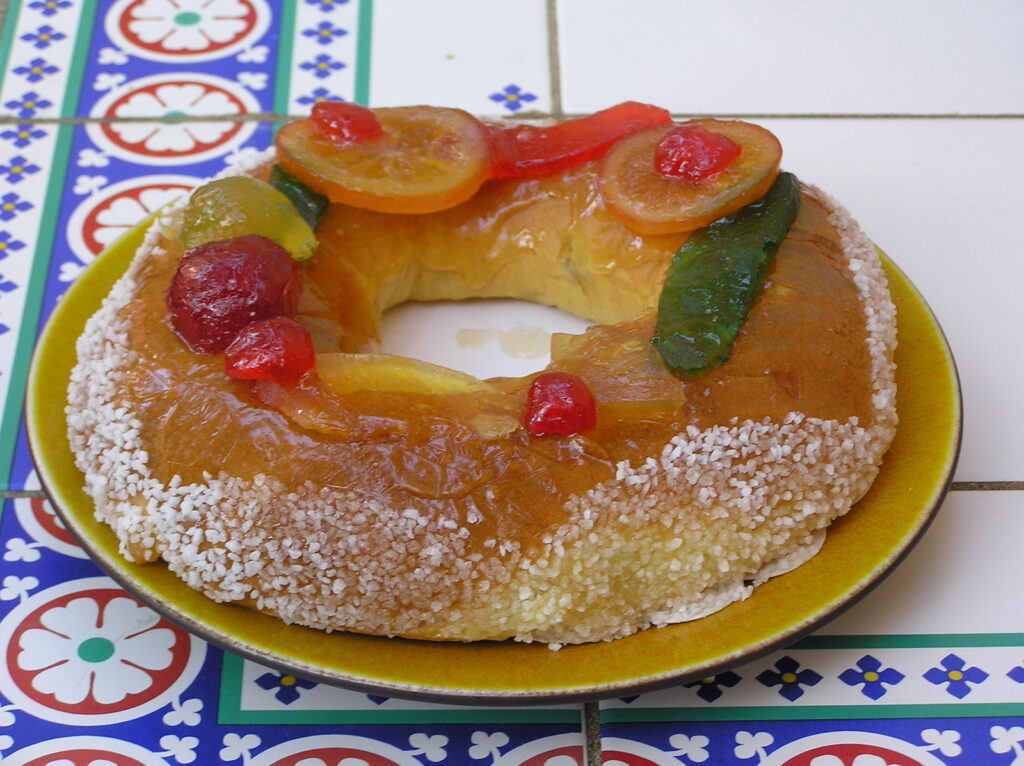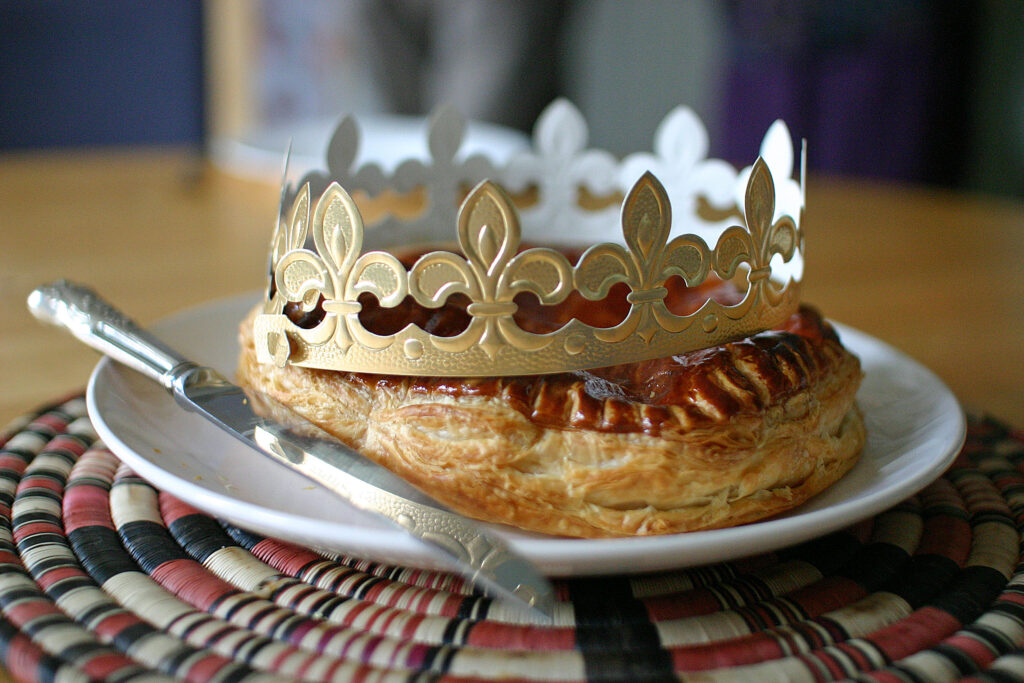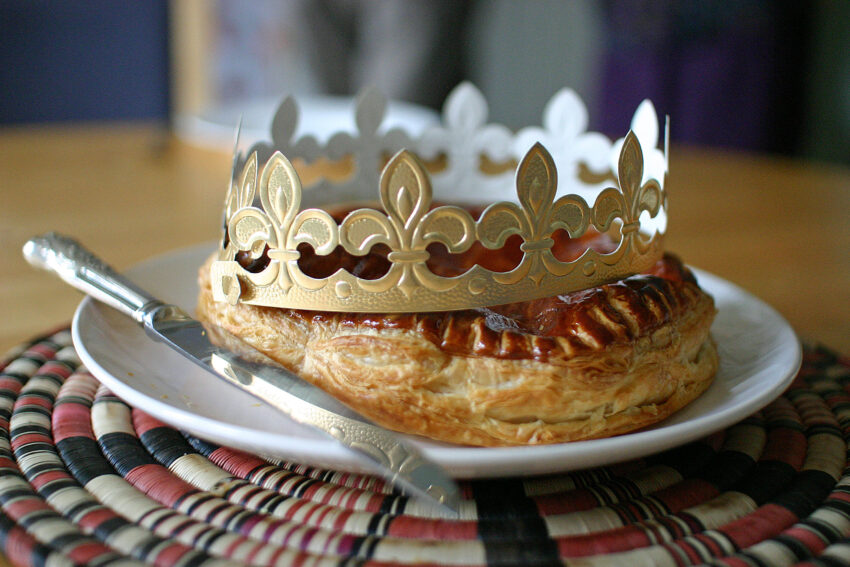The 1st of January marks a momentous occasion every year in France, and no, I’m not talking about the new year! Instead, I am talking about the return of the most delectable of all pastries: the galette des rois [gah–let dey rwa].
The galette is a buttery, sweet and flaky pastry that comes with a little bit of competition. To be honest, it is my addiction and one of the reasons I am so glad to live in France.
What Is This Pastry?
Now that I have admitted my addiction, you are probably curious to know what in the hell a galette des rois actually is.
The galette des rois, translated as king’s cake, is a pastry traditionally eaten during the Epiphany. If you aren’t aware, the Epiphany is a Christian holiday that celebrates the visit of the three Magi (kings) to the baby Jesus. You may recall something about incense, myrrh and gold? Yeah, well, this is it.
North vs. South
The galette has distinct features and names depending on where you are located in France. For instance, in the south, it is named the “gâteau des rois” and follows a completely different recipe. There, the recipe is based off of a brioche flavored with orange blossom and may contain candied fruits. This brioche takes a circular form (said to imitate a crown) and does not contain a fève.

The southern gâteau des rois
However, in the north, we have a completely different type of pastry (the real galette) that comes with a fève! Traditionally, the galette was made “sèche” or dry with only puff pastry, butter and eggs. Now, it is most commonly sold with a frangipane (almond-flavored custard) filling. I have personally seen them offered with apple or even pistachio fillings as well. The possibilities are endless really, but the most popular remains frangipane.

What The F Is A Fève?
I have mentioned the word “fève” [fev] twice so far and you are probably wondering what that is. Simple. Fève is the French term for “fava bean.”
So why would anyone want a cake to have a fava bean inside?
According to anthropologists, this tradition dates back to Roman Saturnalia, a celebration favoring the inversion of roles and equality. This was done through the use of a fève hidden in a cake. The slave who received the piece of cake with the fève would be crowned “king for a day.” To make things fair, it was customary for the youngest to go under the table and decide who would receive the next piece of cake.
After the king was joyously crowned, he chose his queen by throwing the fève in her glass. The rest of the company became part of their court. To celebrate this, all would drink.

A painting by Jacob Jordaens depicting the “Fest des Bohnenkönigs” (Feast of the Bean King) in the 17th century. The woman seated to the “king’s” right seems to be crowned his queen.
Nowadays, it is a competition to see who gets the slice with the fève inside. Essentially, you get a super fancy paper crown and are king/queen for the day! The downside? They must buy the next galette.

Interestingly, Lutherans, Calvinists and Catholics opposed this pagan custom at first, disapproving of the festive side of the galette. Eventually, they gave in and replaced the fava bean with a rendering of the baby Jesus.
The Modern Fève
In 1875, the bean was slowly replaced by figures rendered in Meissen porcelain (from Germany). Later, in 1913, the ateliers of Limoges (in Belgium) began to create their own porcelain fèves. Designs varied, but many took the form of dolls, animals, symbols of luck and, of course, the baby Jesus.
Now, you can find fèves made out of plastic, but ceramic remains tradition. Personally, I have never seen a fève made out of plastic and neither has my husband.







Fèves of various time periods. The first is a baby in a fava bean- how hilarious!
Apparently, fèves are really popular to collect, so much so that there is a word for those who collect them : “favophile.” I suppose such small pieces of ceramic from the late 19th century would be likely to get discarded or lost over time, so we are lucky they are still around!
If you are interested in seeing some in real life, check out the Musée de la Fève et de la Crèche et Traditions Populaires in Blain, Loire-Atlantique!
A Republican Galette
During the French Revolution, the galette nearly disappeared from history. Many revolutionaries associated the galette with Christianity, leading to the replacement of the baby Jesus with a Phrygian cap and the re-naming of the holiday all together.
Although the Phrygian cap was a symbol of liberty for the revolutionaries, the tradition surrounding the fève was, in itself, a symbol of inequality. To combat this, the fève was removed entirely from the cake. Thus was born the galette de la Liberté (Liberty cake) also known as galette de l’Égalité (Equality cake).
Since 1975, the Elysée (the headquarters of the French Republic) receives a galette each January. In respect of the principles of the Republic, and in memory of the legacy of the Revolution, this galette contains no fève. It is, in principle, a galette de l’Égalité.
Galette for l’Elysée by Guillaume Gomez, 2018.
This galette is frickin huge, and is reportedly 40 times the size of a regular one. I would love to know how much this costs because a “normal” galette is expensive enough!
The Cost of a Galette
Speaking of expense, galettes make up a huge chunk of income for the boulangerie every year. Shockingly, nearly 30 million galettes are sold in France annually despite the fact that they are only available between the 26th of December and the 31st of January. Yes, thirty million, with six zeros. Isn’t that crazy?!
What I find most shocking about that number (reminder: thirty MILLION) is that there are so many purchased seeing as galettes are very expensive.
Store-bought “industrial” galettes are, of course, less expensive than those purchased at the boulang’, but let’s be honest, they suck and who really wants to support giant corporations anyways?
(F.Y.I.: “Boulang'” [boo-lahn-j] is the shortened term for “boulangerie” [boo-lanzhuh–ree])
For this reason, I am breaking down the cost of a galette from the boulang’. As an example, I have taken the prices from where I live, although they may vary elsewhere.
Price by the Slice
Galettes are sold like cakes in that they are meant to serve a certain number of people. At my local boulang’, they make galettes for 1, 4 or 6 people in the following flavors: frangipane, apple, or pistachio. I have made a chart to clarify the prices of each:
| Number of Persons | Frangipane/ Apple | Pistachio |
|---|---|---|
| 1 | 4€ | 5€ |
| 4 | 16€ | 20€ |
| 6 | 24€ | 30€ |
As you can see, pistachio is more expensive than frangipane or apple; regardless, they are all expensive! No matter how large of a galette you purchase, you are still paying either 4€ or 5€ per person. With these prices in mind, now you can understand my surprise in that such a large amount of galettes are sold each year.
Is it worth the price though? Hell yes! We have bought 2 galettes already and are only the 6th of January… Told you, I am addicted! Might as well get it before it’s gone, right?!
I hope you have enjoyed learning about one of my absolute favorite pastries and will consider giving one a try on your next trip to France.
If you have already had some before, what was your experience like and what flavor did you try? Have you ever had a southern gâteau des rois?
Tell me all about it in the comments below!
Bisous,
Rose
Read More:

